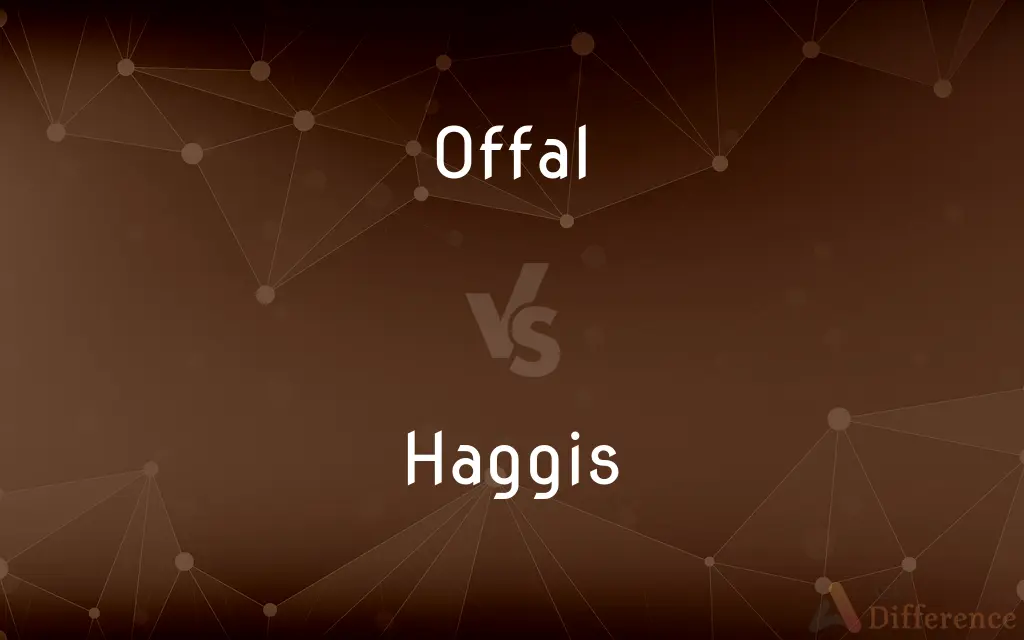Offal vs. Haggis — What's the Difference?
By Urooj Arif & Fiza Rafique — Updated on April 27, 2024
Offal refers to the internal organs and entrails of a butchered animal, used as food, while haggis is a Scottish dish made from minced offal, oatmeal, and spices, encased in an animal's stomach.

Difference Between Offal and Haggis
Table of Contents
ADVERTISEMENT
Key Differences
Offal includes various internal organs such as liver, kidneys, and heart, which are used in a range of culinary traditions. Whereas haggis specifically uses sheep’s offal (heart, liver, and lungs), mixed with oatmeal, onions, and spices, representing a unique Scottish culinary tradition.
Offal is often prepared in diverse ways depending on the culture—fried, stewed, or grilled. On the other hand, haggis is traditionally boiled in the animal’s stomach for several hours, offering a distinct texture and flavor.
Offal can be sourced from different animals like pigs, cows, and chickens, providing a variety of tastes and textures. While haggis is traditionally made using sheep’s offal, making it specific in its flavor profile and ingredients.
Offal is consumed worldwide with varying degrees of popularity and can be found in dishes like liver pâté or tripe stew. Whereas haggis is a national dish of Scotland, closely associated with Scottish identity and celebrated annually on Burns Night.
Offal is appreciated for its nutritional value, particularly high in protein and vitamins. In contrast, haggis is also nutritious but is especially revered for its cultural significance rather than just its health benefits.
ADVERTISEMENT
Comparison Chart
Definition
Internal organs of animals
Scottish dish using sheep's offal
Preparation
Fried, stewed, grilled
Boiled in the animal's stomach
Source of Ingredients
Various animals (e.g., pig, cow)
Primarily sheep
Cultural Significance
Varied, depends on region
Strongly tied to Scottish culture
Common Serving Contexts
Diverse, everyday meals
Traditionally served on Burns Night
Compare with Definitions
Offal
Internal organs used as food.
She prepared a delicious meal using beef offal.
Haggis
Traditional Scottish dish.
He tried haggis for the first time during his visit to Scotland.
Offal
Often used in gourmet cooking.
The chef specialized in dishes made from offal.
Haggis
Made from sheep's organs.
Haggis uses the heart, liver, and lungs of a sheep.
Offal
Known for its nutritional value.
Offal is rich in iron and vitamins.
Haggis
Mixed with oatmeal and spices.
The haggis was seasoned with nutmeg and black pepper.
Offal
Edible by-products of butchering.
Offal includes items like tripe and tongue.
Haggis
Encased in an animal’s stomach.
The haggis was boiled inside a sheep’s stomach for authenticity.
Offal
Consumed worldwide in various dishes.
Offal is particularly popular in European cuisines.
Haggis
Associated with Burns Night.
They served haggis at the Burns Night supper.
Offal
Offal (), also called variety meats, pluck or organ meats, is the organs of a butchered animal. The word does not refer to a particular list of edible organs, which varies by culture and region, but usually excludes muscle.
Haggis
Haggis (Scottish Gaelic: taigeis) is a savoury pudding containing sheep's pluck (heart, liver, and lungs), minced with onion, oatmeal, suet, spices, and salt, mixed with stock, and cooked while traditionally encased in the animal's stomach though now often in an artificial casing instead. According to the 2001 English edition of the Larousse Gastronomique: "Although its description is not immediately appealing, haggis has an excellent nutty texture and delicious savoury flavour".It is believed that food similar to haggis—perishable offal quickly cooked inside an animal's stomach, all conveniently available after a hunt—was eaten from ancient times.Although the name "hagws" or "hagese" was first recorded in England c.
Offal
The entrails and internal organs of an animal used as food
Beef offal
Eating pieces of braised offal turned his stomach
A ban on infective offals being fed to pigs
Haggis
A Scottish dish consisting of a sheep's or calf's offal mixed with suet, oatmeal, and seasoning and boiled in a bag, traditionally one made from the animal's stomach
An enormous haggis was paraded through the hall
We had haggis for supper
Offal
Waste material or byproducts from a manufacturing process.
Haggis
A Scottish dish consisting of a mixture of the minced heart, lungs, and liver of a sheep or calf mixed with suet, onions, oatmeal, and seasonings and boiled in the stomach of the slaughtered animal.
Offal
Meat, including internal organs (such as liver, heart, or kidney) and extremities (such as tail or hooves), that has been taken from a part other than skeletal muscles. Also called variety meat.
Haggis
A traditional Scottish dish made from minced sheep offal with oatmeal and spices, etc., originally boiled in the stomach of a sheep but now often in an artificial casing, and usually served with neeps and tatties (mashed swede and potatoes) and accompanied with whisky.
Offal
Refuse; rubbish.
Haggis
Plural of|en|haggi||one who has participated in a hajj}} ({{alternative spelling of hajjis).
Offal
The internal organs of an animal, used as food.
Haggis
A Scotch pudding made of the heart, liver, lights, etc., of a sheep or lamb, minced with suet, onions, oatmeal, etc., highly seasoned, and boiled in the stomach of the same animal; minced head and pluck.
Offal
A by-product of the grain milling process, which may include bran, husks, etc.
Haggis
Made of sheep's or calf's viscera minced with oatmeal and suet and onions and boiled in the animal's stomach
Offal
A dead body; carrion.
Offal
That which is thrown away as worthless or unfit for use; refuse; rubbish.
Offal
The rejected or waste parts of any process, especially the inedible parts of a butchered animal, such as the viscera.
Offal
A dead body; carrion.
Offal
That which is thrown away as worthless or unfit for use; refuse; rubbish.
The offals of other professions.
Offal
Viscera and trimmings of a butchered animal often considered inedible by humans
Common Curiosities
How is offal prepared in various cuisines?
Offal can be fried, stewed, grilled, or made into sausages, varying widely across different cuisines.
What is offal?
Offal refers to the internal organs and entrails of butchered animals, used as food.
What special occasion is haggis associated with?
Haggis is traditionally associated with Burns Night, a celebration of Scottish poet Robert Burns.
Is haggis available outside of Scotland?
Yes, haggis can be found in various parts of the world, particularly where there is a significant Scottish expatriate community.
Can offal be considered a delicacy?
Yes, in many cultures, certain types of offal are considered delicacies and are highly prized.
What are the most commonly eaten types of offal?
Common types include liver, kidneys, heart, tripe, and brain.
What is haggis made of?
Haggis is made from minced sheep’s offal (heart, liver, lungs), oatmeal, onions, and spices, encased in an animal's stomach.
Are there health benefits to eating offal?
Yes, offal is rich in nutrients like iron, vitamins B and A, and is a good source of protein.
How do cultural perceptions of offal vary?
Cultural perceptions of offal vary greatly, with some cultures treasuring it as a staple and others viewing it with less favor.
Can offal be sourced from all animals?
Offal can be sourced from most butchered animals, including pigs, cows, sheep, and chickens.
How is offal handled to ensure safety?
Offal must be handled with care, kept very fresh, and cooked thoroughly to ensure safety.
What alternatives are there for those who do not want to eat an animal's stomach?
For those avoiding the stomach, haggis is also available in artificial casings or served as a stuffing.
How does the taste of haggis compare to other offal dishes?
Haggis has a distinctive spiced and nutty flavor, which is different from the more straightforward taste of many other offal dishes.
What are the traditional spices used in haggis?
Traditional spices include pepper, nutmeg, and coriander.
Is haggis always made with sheep's offal?
Traditional haggis is made with sheep’s offal, but variations can use other types of meat.
Share Your Discovery

Previous Comparison
Hardcover vs. Hardback
Next Comparison
Designation vs. AppointmentAuthor Spotlight
Written by
Urooj ArifUrooj is a skilled content writer at Ask Difference, known for her exceptional ability to simplify complex topics into engaging and informative content. With a passion for research and a flair for clear, concise writing, she consistently delivers articles that resonate with our diverse audience.
Co-written by
Fiza RafiqueFiza Rafique is a skilled content writer at AskDifference.com, where she meticulously refines and enhances written pieces. Drawing from her vast editorial expertise, Fiza ensures clarity, accuracy, and precision in every article. Passionate about language, she continually seeks to elevate the quality of content for readers worldwide.
















































